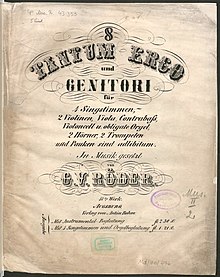Georg Valentin Roeder
Georg Valentin Röder , sometimes also Georg Vincent Röder (born November 21, 1776 in Unterebersbach , † December 30, 1848 in Altötting ) was a German composer and musician .
Life
Röder's home is Rannungen in Lower Franconia . His father was the teacher Johann Michael Röder (1751-1838) from Pfändhausen , his mother Margaretha (née Wehner) came from Rottershausen near Rannungen. Their first child Georg Valentin was born in Unterebersbach, where the father was a schoolmaster for some time. A short time after the birth, the young family returned to Rannungen, where Valentin's seven siblings were born. He grew up with them in the former schoolhouse. This explains why Röder's first biographers, some of whom knew him personally, regard Rannungen as his place of birth.
The father, a musical man who also composed, first taught his eldest son music himself, then Röder attended the grammar school of the Augustinian monastery in Münnerstadt . After graduating from high school, Röder studied law at the University of Würzburg , where he also worked as an organist at the Juliusspital and worked as a private tutor. During this time he became acquainted with the composer Ignaz Franz Xaver Kurzinger , music director at the Juliusspital, where the young musician received further training in composition technology.
From 1801 Röder was employed as a cellist in the Würzburg court orchestra, and from 1808 music director at the theater in Würzburg. After that he was probably working as a freelancer. After a performance of his first mass in Munich, he is said to have received a “precious golden box adorned with an excellent mosaic painting” and a letter of thanks from King Max Joseph . It was not until 1830 that he was found as music director in Augsburg, where he also worked with the poet Christoph von Schmid .
A call from King Ludwig I led him to the capital and residence city of Munich in 1837 , where he worked as court music director at the royal court opera . However, there was rivalry here with the Kapellmeister colleagues (e.g. Franz Lachner ), so that the king finally got him the post of conductor of the collegiate and band music in Altötting in 1842, where Röder worked until his death.
Röder had married during his time in Würzburg; it is not known how many children resulted from the marriage. A son born in Würzburg died as a child. It is also certain that Röder's “not quite seven-year-old daughter” took over the solo soprano roles in the second Augsburg performance of “Messiad” (1831) under the direction of her father.
Röder's works were popular and widespread in southern Germany and Austria in the 19th and early 20th centuries, but were forgotten.
Works (selection)
Operas and drama music
- The Passion or The Life and Suffering of our Lord (text: Hofmann / Holzapfel), performance: January 30, 1817
- Moses , hist.-rom. Poem with song (text: E. Fr. A. Klingemann ), premiere: July 16, 1820
- The Ghost (text: August von Kotzebue ), premiere: February 11, 1818
- Hermann and Thusnelda (Text: AvKotzebue), premiere: October 5, 1815
- Der Verräter (Text: Wilhelm Vogel), premiere: May 26 or 29, 1816
- The Swedes in Prague (text: Johann Grötsch based on the novel by Caroline Pichler ), premiere: November 28, 1842 (at the National Theater in Munich)
- The boulder and the emperor's daughter
Oratorios
- Caecilia or The Celebration of Music (Text: Christoph von Schmid )
- Messiade (text: Karl Wilhelm Ramler ), premiere: 1822
Spiritual works
- Three solenne Latin masses op. 32–34
- Solenne Mass op.35
- 24 Marian antiphons op.36
- Vesperae de Dominica op.44
- Vesperae de Beata op.45
- Three Latin masses op. 46–48
- Eight Tantum ergo op.51
- Litaniae Lauretanae op.52
- Solennes Requiem in F minor op.53
- Solennes Requiem in C minor, Op. 54
- Vespers psalms for all festivals of the year, along with antiphons of the 4 church times
- Four cantatas for the Feast of Corpus Christi
Other works
There are only vague references to other works by the composer:
- Symphonies
- Chamber music
- Organ music
- Music-theoretical writing on the aesthetics of musical art
literature
- Robert Eitner : Röder, Georg Vincent . In: Allgemeine Deutsche Biographie (ADB). Volume 29, Duncker & Humblot, Leipzig 1889, p. 17 f.
Web links
- Website of the Würzburg Philharmonic Orchestra
- Website of Manfred Hößl with works by Georg Valentin Röder im. MID format
- Link to the digitized works of Röder in the Bavarian State Library
Individual evidence
- ↑ Augsburg magazine for entertainment and instruction No. 40 (1831), p. 158
- ^ Augsburg magazine for entertainment and instruction, No. 40 (1831), p. 158
| personal data | |
|---|---|
| SURNAME | Röder, Georg Valentin |
| ALTERNATIVE NAMES | Röder, Georg Vincent |
| BRIEF DESCRIPTION | German composer and musician |
| DATE OF BIRTH | November 21, 1776 |
| PLACE OF BIRTH | Unterebersbach |
| DATE OF DEATH | December 30, 1848 |
| Place of death | Altötting |
